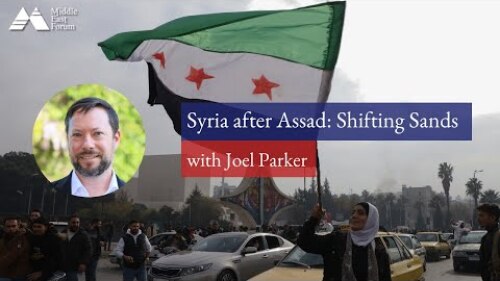|
|
Alireza Nader, former senior researcher at the RAND Corporation and a senior fellow at the Foundation for the Defense of Democracies (FDD), is engagement director at the National Union for Democracy in Iran (NUFDI). Nader spoke to an April 14th Middle East Forum Webinar (video) in an interview with Cliff Smith, director of the Middle East Forum’s Washington Project, about conditions facing the protesters challenging the Iranian regime. The following is a summary of Nader’s comments:
There have been seven uprisings against the Islamic Republic since 2017. Thousands killed by the regime in the 2019 uprising spurred the protests on, but after the arrest and murder of Mahsa Amini in police custody last September, mass demonstrations have spread from the streets in Tehran to cities, towns, and villages across Iran. The regime’s brutal crackdown against the people has ranged from “shooting young men and women in the eye during the demonstrations” to the torture and execution of young prisoners. In response, the revolutionaries have shifted from mass demonstrations to resisting the regime in other ways.
Iranians are “celebrating Iran’s pre-Islamic past” at national sites, such as the tomb of the Persian king Cyrus the Great, and are gathering to challenge the regime during traditional national holidays, many of them Zoroastrian in origin. Security forces did not interfere during a gathering at a tomb in Shiraz, where protesters celebrated Hafez, the ancient Persian poet. This supports reports that these forces, including elements of the Islamic Revolutionary Guards Corps (IRGC), disapprove of the regime’s actions against the people. Even though the violent cadre of those paramilitary forces still “ideologically committed” to Ayatollah Khamenei engage in “inhumane and violent” behavior towards the Iranian people, there are individuals within these forces that cannot publicly express their desire for the Islamic Republic to be gone.
The revolution has become more localized, organized by “neighborhood committees” engaging in acts of resistance. Some women in Tehran continue to refuse to wear the compulsory hijab, sometimes boldly appearing so next to “police cars and regime security agents.” Even though many are beaten and arrested, security forces are increasingly fearful of challenging these women. The regime is using advanced technologies to monitor women who forego the hijab to text them warnings.
In recent months, thousands of young schoolgirls in more than three hundred schools have been poisoned. Nader is convinced the regime is sending a warning to Iranian women because high school girls, joined by their parents and teachers, were instrumental in leading demonstrations. While this mass attack has not been given enough coverage in the Western media, Nader believes the poisonings are the regime’s attempt to deter further protests and demonstrations.
The figure in exile that has “emerged as opposition leader amongst broad layers of Iranians” is Crown Prince Reza Pahlavi. Along with other activists, he spoke on the revolution’s behalf at the Munich Security Conference, which is significant since past conferences featured regime officials from the Islamic Republic. Supporters “mobbed” Pahlavi when he spoke at Oxford University, and when he appeared in Los Angeles to speak on behalf of the Iranian people, an estimated 80,000 supporters of the protests attended. Although Pahlavi has gained the support of the “constitutional monarchists,” many of those Iranians who prefer a “parliamentary republic” also support him as a “figurehead leader.”
It is easy for those outside of Iran to have the misimpression that the revolution has abated because of the scant English language media coverage. The lack of support from the international community, as well as the response by the Biden administration that offered “little beyond rhetoric,” belies the energy of the resistance on the ground in Iran. Disregarding the regime’s attempts on social media to sow division and sabotage the movement’s momentum, the “vast majority” of Iranians decided to “put aside their differences” and are united and resolute in their expectations that the regime will be overthrown.
A “major hurdle” is the unwillingness of European officials to designate the Islamic Revolutionary Guards Corps as a terrorist organization.
The Iranian diaspora has exerted pressure on European allies by holding mass protests in cities such as Paris, Berlin, and Brussels. There has been a noticeable shift in Europe’s view of the Islamic Republic in light of the failed policy of the nuclear agreement, a.k.a. the Joint Comprehensive Plan of Action (JCPOA). A “major hurdle” is the unwillingness of European officials to designate the Islamic Revolutionary Guards Corps (IRGC) as a terrorist organization. Despite an ongoing hunger strike waged by an Iranian in the UK, Britain has refused to act.
Germany also refuses to blacklist the IRGC. Authorities there have not closed multiple “so-called religious centers” run by the Iran that have been involved in acts of terrorism, including a recent IRGC-linked attack on a synagogue in Berlin. In addition, by providing drones to Putin to attack Ukraine, the regime is actively “combating European interests in Eastern Europe.” The regime is also still targeting Americans for assassination. “The JCPOA is not the answer to this problem. The answer to the problem that the Islamic Republic presents is the overthrow of this regime and a replacement by a secular democracy supported by the majority of the people of Iran.”
Many European governments have a history of appeasing Iran that goes back decades. Tehran’s assassinations and terrorist acts in Europe have elicited little governmental reaction. A key impediment is Joseph Borell, “the European official responsible for the nuclear portfolio,” who is close to Robert Malley, the U.S. envoy for Iran. Borell insists the JCPOA can stop Iran’s nuclear program, “contrary to all evidence.” Borell and other European officials either “don’t want the revolution in Iran to succeed or don’t believe that it will succeed.”
The Biden administration pays lip service to defending human rights, yet does little for the women’s struggle for human rights in Iran.
The Biden administration pays lip service to defending human rights, saying it is a “major part of U.S. foreign policy,” yet does little for the women’s struggle for human rights in Iran. Senior administration officials still hope Iran will rejoin the nuclear agreement. In lobbying the U.S. and Europe to pass JCPOA, Iranian regime proxies mislead the public with anti-war rhetoric while helping Iran cover up its “crimes against humanity.” Iranian Americans and their allies are aware of the manipulation by the Islamic Republic’s proxies, but American media offer a veneer or legitimacy to such actors. Publications such as Foreign Affairs still offer a platform from which these networks can operate.
Israel, however, understands the importance of Iran’s ongoing revolution, because it knows the regime’s downfall would benefit not only benefit the Iranian people, but the entire world by ending the leading state sponsor of terrorism. Meanwhile, the regime continues to fuel conflict via its partners, proxies, and terrorist organizations across the Middle East.
Iranian Americans actively advocate for the passage of the Mahsa Act in Congress, named for Mahsa Amini, which enjoys bipartisan support. If adopted, the act will ask the Biden administration to directly sanction Supreme Leader Ayatollah Khamenei and Iran’s president, Ebrahim Raisi, who is responsible for executing innocent Iranians. The Mahsa Act is a “good starting point,” and the public can play a key role in its passage by pressuring more members of Congress to become co-sponsors. The common goal of the people of Iran is to overthrow the Islamic Republic and “hold a referendum” to choose their own political system and replace the tyranny of the ayatollahs with a secular government.





